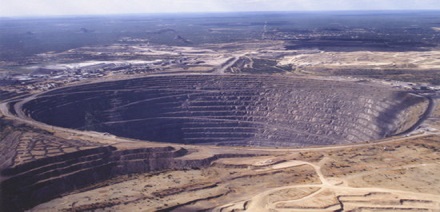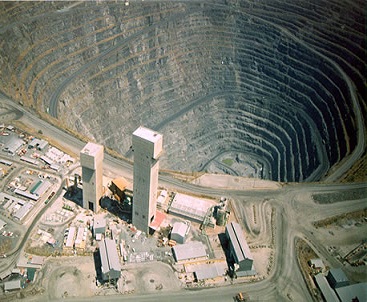Copper ore processing in Palabora Mining South Africa decided to extend the underground mining of copper. Below the surface mining blocks with a daily production of 30,000 tons is an acceptable way of economically maximize the recovery of the deposit. This will facilitate the copper ore processing in Palabora Mining South Africa were at least able to walk for 20 years. When mining the copper deposits below the surface, it is planned to increase further the efficiency of mining process of copper using modern equipment automation and tele-controlled machine. The aim is to extend the daily operations, increase productivity, integrating data acquisition and diagnostic features and increase the level of automation. On the one hand, the system is designed to provide comprehensive information on the operations throughout the mine to management. At the same time, the operating personnel in the control panel needs direct control and monitoring of underground mining activities.
Underground Copper Ore Stream in Palabora Mining South Africa
 Copper ore from the underground block-cave mine – less than 300mm in size – is conveyed to two stockpiles, each feeding two separate, autogenous wet-grinding circuits. These in turn, each comprise a 9.75 meter-diameter tumbling mill rotated by 2 x 3.5 MW drives. Large rocks impact, scrub and attrition against each other, reducing their size, which results in the liberation of the copper sulphides.
Copper ore from the underground block-cave mine – less than 300mm in size – is conveyed to two stockpiles, each feeding two separate, autogenous wet-grinding circuits. These in turn, each comprise a 9.75 meter-diameter tumbling mill rotated by 2 x 3.5 MW drives. Large rocks impact, scrub and attrition against each other, reducing their size, which results in the liberation of the copper sulphides.
Mill products are sized by vibrating screens to produce coarse feed to the pebble crushers. Fine particles of 0.3mm removed from the circuit as the main product of milling up to 30,000Tpd (tonnes per day?) Product rough cyclone underflow is recycled. Cyclone overflow from both circuits is then pumped 1.5 kilometres to the secondary milling plant (SMP) where the ore is further ground to less than 0.15mm, using steel balls in up to five parallel 1.2 MW milling circuits. Secondary milling has been applied since 2003 by reconfiguring the existing equipment. This is to improve the liberation and recovery of copper in underground ore grade higher.
Chemicals are added to allow the copper sulfide particles to separate from the fine ore particles through the process of ‘froth flotation’. A xanthate collector metered into the slurry and adsorbs to the particles to the copper sulfide to increase their hydrophobicity. Frother also added to produce a stable foam. The flow is then divided between the parallel rows of flotation cells. Each row contains several agitator to maintain the suspension and for the air to disperse the slurry. As the air bubbles rise to the surface of the cell, the copper mineral particles attach hydrophobic privileged to bubble and form a stable foam, which continues to overflow into launders. The process is then repeated two more times to recover almost 90% of the copper feed to only 2% of the weight of feed to produce 32% of copper sulphide concentrates. The latter is then pumped to the dewatering plant.
Conventional Process Leaching Of Copper in Palabora Mining South Africa
Transition to underground mining has allowed 50,000 tpd of destroying conventional milling and flotation capacity. Copper and magnetite recovered on behalf of Foskor (neighboring mining company) by a 20,000 tpd ore processing toll marginal of stock from open pit operations. These Conventional process leaching of copper are also applied to underground ore available in more than autogenous grinding capacity.
A main rotating crusher is used to reduce the dump material from 200mm to 1500mm down in size before relaying to one of the two stocks. Feeders and conveyors transport the ore to a two-stage dry crushing plant where two secondary crushers reduce the size to below 50mm. Additionally, 5 tertiary crushers further reduce the ore to below 20mm, operating in closed circuit with vibrating screens. Crushing plant product is then conveyed 1.4 kilometres to fill any one of six fine ore bins, each one feeding six rod mill flotation sections, all operating in parallel. Certain sections are used for wet grinding marginal ore to below 0.3mm, followed by a copper flotation process similar to that used for the underground ore. Concentrate is pumped to a dewatering plant, while magnetite removed from the tailings thickening and pumping before the final product for Foskor for flotation of phosphate
A third secondary crusher-feed stockpile is reserved for ‘minus 200mm’ underground ore that can be diverted by means of a moveable chute and transfer conveyor. Underground ore is batched through the secondary crushing plant and directed to the fine ore bins. Each section is able to grind 6,000 Tpd of ore finer than 0.2mm before froth flotation.
Dewatering, Magnetite Production And Tailings Disposal In Palabora Mining South Africa
Concentrated sludge is pumped to a thickener using a vacuum filter disc and rotary dryers coal successively removing water to reach 8% residual moisture. Dryer product weighed by the belt scale and sample before submission to the receiving warehouse smelter. Flotation tailings from the second circuit and conventional Autogenous pumped into magnetic separation plant, where a rotating magnetic drum magnetite extract 16% by weight of the slurry. Nine three-drum magnets are used for the three stages of upgrades to produce up to 5,000 TPD of 98% pure magnetite concentrate. The concentrate separated into two size by rising currents of water (elutriasi). On average, 600 TPD fine magnetite directed to classifier overflow, thickened, filtered and stockpiled prior to the delivery of domestic heavy media consumers who are used to upgrade coal. The majority of magnetite to be transported to underflow classifier and then pumped either to drying of the desert to the fence and export, or dam large magnetite deposit, depending on the sales commitment. Export magnetite is used for the production of iron and steel.
After removing magnetite, ore tailings underground flows to three
parallel 90 meter diameter tailings thickener to recover and reuse
water, while the combined underflows pumped to various points around the
perimeter of a large tailings dams. The dam wall is maintained at a
higher level with coarse solids beach. Fines flowing into the central
pool, where the clear water contained by the siphon and stored in a dam
the water back for reuse in the process.



















